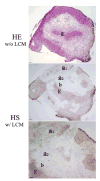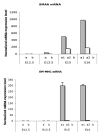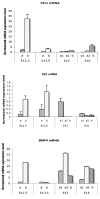Signalling molecules involved in mouse bladder smooth muscle cellular differentiation
- PMID: 20013655
- PMCID: PMC2855152
- DOI: 10.1387/ijdb.082610bl
Signalling molecules involved in mouse bladder smooth muscle cellular differentiation
Abstract
Mouse bladder mesenchyme differentiates into smooth muscle under the influence of urothelium at gestational day 13.5 (E13.5). Sonic hedgehog (Shh) is considered to be the upstream gene arising from the urothelium, which induces smooth muscle in the peripheral bladder mesenchyme. We hypothesize differential gene expression across the full thickness of bladder mesenchyme as a function of proximity to the inducing bladder urothelium and the peripheral location of the smooth muscle. Embryonic bladders from FVB mice were collected at E12.5, 13.5, 15 and 16 and cryosectioned followed by microdissection with a PixCell II laser capture microscope. RNA extraction was performed at the laser captured sites and mRNA expression profiles were measured using SYBR Green quantitative RT-PCR. Smooth muscle a-actin (SMAA) and smooth muscle myosin heavy chain (SM-MHC) were expressed in the E13.5, E15 and E16 bladders in the peripheral layer of mesenchyme, but not in the prospective submucosa. Patched 1 (Ptc1), Gli1 and bone morphogenetic protein (Bmp) 4 expression was consistently elevated in the mesenchymal layer immediately adjacent to the urothelium compared to the peripheral location at E12.5. After E12.5, Ptc1 expression decreased to an undetectable level throughout the bladder mesenchyme. The level of TGF-beta1 was highest in the mesenchymal layer adjacent to the serosa at E13.5. The level of expression of serum response factor (SRF) was also highest at E15 in the peripheral mesenchyme. Genes downstream of Shh are differentially expressed in the prospective submucosa vs. the peripheral bladder mesenchyme as a function gestation age and smooth muscle differentiation.
Figures






Similar articles
-
Smooth muscle differentiation and patterning in the urinary bladder.Differentiation. 2010 Sep-Oct;80(2-3):106-17. doi: 10.1016/j.diff.2010.05.004. Epub 2010 Jun 12. Differentiation. 2010. PMID: 20541860 Free PMC article. Review.
-
Urothelial sonic hedgehog signaling plays an important role in bladder smooth muscle formation.Differentiation. 2007 Dec;75(10):968-77. doi: 10.1111/j.1432-0436.2007.00187.x. Epub 2007 May 9. Differentiation. 2007. PMID: 17490411
-
Serum response factor, its cofactors, and epithelial-mesenchymal signaling in urinary bladder smooth muscle formation.Differentiation. 2006 Feb;74(1):30-9. doi: 10.1111/j.1432-0436.2006.00057.x. Differentiation. 2006. PMID: 16466398
-
Spatio-temporal distribution of Smads and role of Smads/TGF-β/BMP-4 in the regulation of mouse bladder organogenesis.PLoS One. 2013 Apr 19;8(4):e61340. doi: 10.1371/journal.pone.0061340. Print 2013. PLoS One. 2013. PMID: 23620745 Free PMC article.
-
Cellular signaling in the bladder.Front Biosci. 1997 Dec 1;2:d592-5. doi: 10.2741/a215. Front Biosci. 1997. PMID: 9374449 Review.
Cited by
-
Fgfr2 is integral for bladder mesenchyme patterning and function.Am J Physiol Renal Physiol. 2017 Apr 1;312(4):F607-F618. doi: 10.1152/ajprenal.00463.2016. Epub 2017 Jan 4. Am J Physiol Renal Physiol. 2017. PMID: 28052872 Free PMC article.
-
An illustrated anatomical ontology of the developing mouse lower urogenital tract.Development. 2015 May 15;142(10):1893-908. doi: 10.1242/dev.117903. Epub 2015 May 12. Development. 2015. PMID: 25968320 Free PMC article.
-
Genetics of human congenital urinary bladder disease.Pediatr Nephrol. 2014 Mar;29(3):353-60. doi: 10.1007/s00467-013-2472-1. Epub 2013 Apr 13. Pediatr Nephrol. 2014. PMID: 23584850 Review.
-
Spatiotemporal Expression of SHH/GLI Signaling in Human Fetal Bladder Development.Front Pediatr. 2021 Dec 22;9:765255. doi: 10.3389/fped.2021.765255. eCollection 2021. Front Pediatr. 2021. PMID: 35004540 Free PMC article.
-
Smooth muscle differentiation and patterning in the urinary bladder.Differentiation. 2010 Sep-Oct;80(2-3):106-17. doi: 10.1016/j.diff.2010.05.004. Epub 2010 Jun 12. Differentiation. 2010. PMID: 20541860 Free PMC article. Review.
References
-
- Baskin LS, Hayward SW, Young P, Cunha GR. Role of mesenchymal–epithelial interactions in normal bladder development. J Urol. 1996;156:1820–7. - PubMed
-
- Bonner RF, Emmert-Buck M, Cole K, Pohida T, Chuagui R, Goldstein S, Littoa LA. Laser capture microdissection: molecular analysis of tissue. Science. 1997;278:1481–1483. - PubMed
-
- Bragg AD, Moses HL, Serra R. Signaling to the epithelium is not sufficient to mediate all of the effects of transforming growth factor beta and bone morphogenetic protein 4 on murine embryonic lung development. Mech Dev. 2001;109:13–26. - PubMed
-
- Browning CL, Culberson DE, Aragon IV, Fillmore RA, Croissant JD, Schwartz RJ, ZiImmer WE. The developmentally regulated expression of serum response factor plays a key role in the control of smooth muscle-specific genes. Dev Biol. 1998;194:18–37. - PubMed
Publication types
MeSH terms
Substances
Grants and funding
LinkOut - more resources
Full Text Sources
Molecular Biology Databases
Research Materials
Miscellaneous

